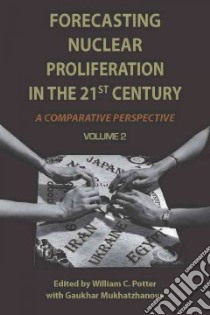Forecasting Nuclear Proliferation in the 21st Century - 9780804769716
Un libro in lingua di Potter William C. (EDT) Mukhatzhanova Gaukhar (CON) edito da Stanford Security Studies, 2010
- € 26.20
- Il prezzo è variabile in funzione del cambio della valuta d’origine
"This volume contains twelve case studies and offers a great deal of insight into the decision-making processes in the countries studied. It will be invaluable to those interested in prolifertion analysis, and to students and researchers."---T.V. Paul James McGill Professor of International Relations, McGill University
In 2007, the James Martin Center for Nonproliferation Studies (CNS) at the Monterey Institute of International Studies engaged a group of leading scholars and practitioners in a two-year research project, with a mandate to combine cutting-edge social science theory and country/area studies expertise for the purpose of forecasting proliferation developments in twelve key states---both "the usual suspects" and some states under the nonproliferation radar.
The output from that project has been gathered into two separate books---one theoretical and one applied---so that policy makers, analysts, researchers, and students may use them together or separately depending on their aims.
Volume 2, A Comparative Perspective, provides the most comprehensive and authoritative projections of nuclear proliferation over the next decade and offers a range of practical nonproliferation measures. The authors address a set of overarching questions regarding the propensity of selected states from different regions of the world to "go nuclear," the sources of national decisions to do so, and the potential for one state's proliferation behavior to impact on that of other states. In addition, authors address the most effective policy tools available for impeding nuclear weapons spread. Although this volume is not the first effort to look systematically and comparatively at nuclear decision-making, it is unique in its combination of future orientation, comparative perspective, and emphasis on harnessing the insights from social science theory and country case studies to aid policy makers in forecasting nuclear proliferation developments.
Informazioni bibliografiche
- Titolo del Libro in lingua: Forecasting Nuclear Proliferation in the 21st Century
- Sottotitolo: A Comparative Perspective
- Autori : Potter William C. (EDT) Mukhatzhanova Gaukhar (CON)
- Editore: Stanford Security Studies
- Collana: Stanford Security Studies (Paperback)
- Data di Pubblicazione: 03 Agosto '10
- Genere: POLITICAL SCIENCE
- Argomenti : Nuclear nonproliferation Forecasting
- Pagine: 471
- ISBN-10: 0804769710
- EAN-13: 9780804769716


